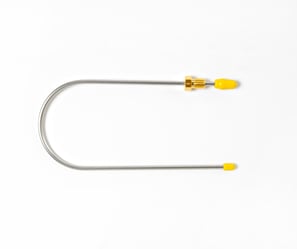 Purge & Trap (P&T) concentration is a common technique used for the analysis of Volatile Organic Compounds. An analytical trap is the major component of any P&T system and is responsible for trapping the analytes purged from a sample, and then after heating, releasing them for further analysis.
Purge & Trap (P&T) concentration is a common technique used for the analysis of Volatile Organic Compounds. An analytical trap is the major component of any P&T system and is responsible for trapping the analytes purged from a sample, and then after heating, releasing them for further analysis.
An analytical trap choice for Purge and Trap concentration offers specific challenges for end users. Most standard methods define the dimensions of the trap, as well as recommend packing materials. There are several packing choices that can be substituted, however, provided they meet the analytical requirements of the method.
We recently published a new trap guide that describes the characteristics of the traps, compounds they retain, and their ideal operating conditions. In some cases, a trap choice can be as specific as a single agent for one particular class of compounds or as diverse as multiple agents for several compound classes.
The requirements for an analytical trap include:
- At low temperatures, it must retain the desired analytes while allowing oxygen and water to pass through unimpeded.
- It must release the analytes quickly and efficiently upon heating
- Must not contribute any volatiles of interest to the system.
- Must operate without causing any catalytic reactions
- Should have a reasonable price and lifetime.
Click to download the Trap Reference Guide
At lower trap temperatures, retention volumes are high. At higher desorption temperatures, retention volumes are much smaller, allowing rapid transfer to the GC. In this context, the use of retention time is not correct. The correct parameter is retention volume.
When elution does occur it is usually referred to as breakthrough, and the retention volume at which breakthrough occurs is often referred to as breakthrough volume. Sorbent materials are usually chosen so that the breakthrough volume is high for analytes and low for water. Care must be taken so that the sorbent chosen does not retain the analytes too strongly or efficient desorption may not be possible. Traps containing combinations of sorbents are often used to enhance performance.
The trap is packed with the weaker sorbent on top. The stronger sorbent is placed below the weaker sorbent. Less volatile analytes that are not effectively desorbed by the stronger sorbent are retained by the weaker sorbent. In other words, the less volatile analytes fail to reach the stronger sorbent, only the more volatile analytes reach the stronger sorbent. Because of their volatility, these analytes can be efficiently desorbed. Desorption is carried out by backflushing the trap, ensuring that heavier compounds never come into contact with the stronger sorbent.
Common Purge & Trap Terms
- Purge Ready – Achieved when the trap is at the required temperature to start analysis
- Purge Time – The amount of time used to extract the analytes from the sample matrix and deposit them onto the trap via an inert gas stream
- Purge Temperature – The desired temperature of the trap during the purging process. Typically set as low as the ambient environment allows
- Purge Flow – The flow rate at which the inert gas is controlled for extraction and compound delivery
Download our Trap Guide at TeledyneTekmar.com for more common terms, EPA Methods and Tekmar recommended trap choices, preferred method parameters for Stratum PTC and Velocity XPT, as well as a trap selection table and VOC property table.
